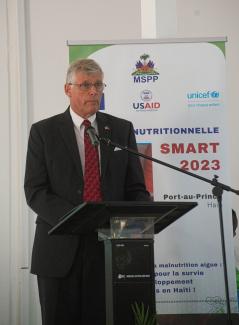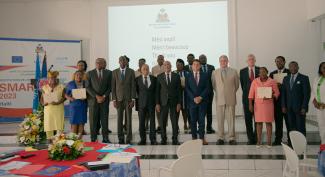With USAID support, UNICEF conducted the 2023 Nutrition Analysis.
Nutritional deficiency is a long-standing challenge in Haiti. According to the UN Food and Agriculture Organization, roughly 50 percent of Haiti’s population is undernourished. The latest data available from the UN Children’s Fund (UNICEF) indicates that nearly one in four children under the age of five years is stunted, or suffering from chronic malnutrition. According to the 2023 nutrition analysis conducted by UNICEF and with support from the United States Agency for International Development (USAID), high levels of wasting—the deadliest form of malnutrition—were identified in Haiti’s capital city of Port-au-Prince, including emergency levels of wasting in five of the capital’s eight communes. Wasting can be caused by a lack of nutritious food and diseases such as cholera and malaria that reduce children’s ability to absorb essential nutrients. Deficiencies in micronutrients lead to decreased cognitive development and productivity, and weakened immune systems.
On May 11, 2023, the Government of Haiti (GoH) Ministry of Public Health and Population and UNICEF presented the preliminary findings of the national nutrition Standardized Monitoring and Assessment of Relief and Transitions (SMART) survey at an event attended by GoH Prime Minister Ariel Henry and U.S. Chargé d'Affaires Ambassador Eric W. Stromayer. The survey, done through a hybrid model including both departmental and communal level data, revealed the critical nutritional situation of many communes of Haiti. The Chargé highlighted the need for collaboration between nutrition, water, sanitation, and other sectors and encouraged humanitarian donor support in expanding nutrition and multi-sector humanitarian response.
To address this challenge, USAID funds the “Ranfòse Abitid Nitrisyon Pou Fè Ogmante Sante” (RANFOSE) project which works in collaboration with the GoH to reduce micronutrient deficiencies in Haiti through large scale food fortification. This project is working with importers, distributors, and local food producers to fortify wheat flour with iron and folic acid, vegetable oils with vitamin A, and salt with iodine. With RANFOSE support, 76 percent of all wheat flour and 80 percent of vegetable oil in Haiti is fortified.

Emile Manigat/USAID

Emile Manigat/USAID

Emile Manigat/USAID
